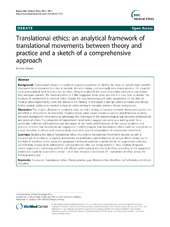| dc.contributor.author | Bærøe, Kristine | en_US |
| dc.date.accessioned | 2014-10-07T13:06:49Z | |
| dc.date.available | 2014-10-07T13:06:49Z | |
| dc.date.issued | 2014-09-30 | eng |
| dc.identifier.issn | 1472-6939 | |
| dc.identifier.uri | https://hdl.handle.net/1956/8601 | |
| dc.description.abstract | Background: Translational research in medicine requires researchers to identify the steps to transfer basic scientific discoveries from laboratory benches to bedside decision-making, and eventually into clinical practice. On a parallel track, philosophical work in ethics has not been obliged to identify the steps to translate theoretical conclusions into adequate practice. The medical ethicist A. Cribb suggested some years ago that it is now time to debate ‘the business of translational’ in medical ethics. Despite the very interesting and useful perspective on the field of medical ethics launched by Cribb, the debate is still missing. In this paper, I take up Cribb’s invitation and discuss further analytic distinctions needed to base an ethics aiming to translate between theory and practice. Discussion: The analytic distinctions needed to base an ethics aiming to translate between theory and practice are identified as ‘movements of translation’. I explore briefly what would constitute success and limitations to these intended translational movements by addressing the challenges of the epistemological gap between philosophical and practical ethics. The categories of translational movements I suggest can serve as a starting point for a systematic, collective self-inspection and discussion of the merits and limitations of the various academic and practical activities that bioethicists are engaged in. I further propose that translational ethics could be considered as a new discipline of ethical work constructively structured around compositions of translational movements. Summary: Breaking the idea of translational ethics into distinct translational movements provide us with a nuanced set of conditions to explore and discuss the justification and limitations of various efforts carried out in the field of bioethics. In this sense, the proposed framework could be a useful vehicle for augmented collective, self-reflexivity among both philosophers and practitioners who are ‘doing bioethics’. Also, carefully designed, overall approaches combining justified, self-reflexive philosophical and practical efforts according to the suggested distinctions could be expected to realise – or at least improve a facilitation of – translation of ethics across the theory-practice gap. | en_US |
| dc.language.iso | eng | eng |
| dc.publisher | BioMed Central | eng |
| dc.rights | Attribution CC BY | eng |
| dc.rights.uri | http://creativecommons.org/licenses/by/4.0 | eng |
| dc.subject | Translation | eng |
| dc.subject | Translational ethics | eng |
| dc.subject | Theory-practice gap | eng |
| dc.subject | Medical ethics | eng |
| dc.subject | Bioethics | eng |
| dc.subject | Self-reflexivity and ethical discipline | eng |
| dc.title | Translational ethics: an analytical framework of translational movements between theory and practice and a sketch of a comprehensive approach | en_US |
| dc.type | Peer reviewed | |
| dc.type | Journal article | |
| dc.date.updated | 2014-10-07T03:03:46Z | |
| dc.description.version | publishedVersion | en_US |
| dc.rights.holder | Kristine Bærøe et al.; licensee BioMed Central Ltd. | |
| dc.rights.holder | Copyright 2014 2014 Bærøe; licensee BioMed Central Ltd. | |
| dc.source.articlenumber | 71 | |
| dc.identifier.doi | https://doi.org/10.1186/1472-6939-15-71 | |
| dc.identifier.cristin | 1188696 | |
| dc.source.journal | BMC Medical Ethics | |
| dc.source.40 | 15 | |

